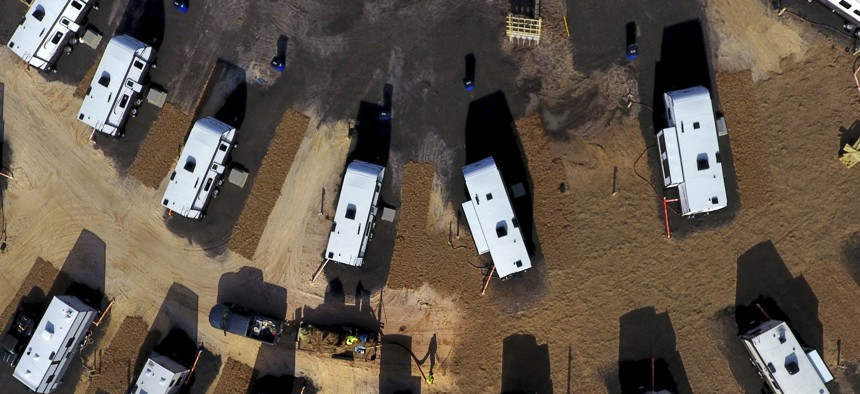The Slow Process of Post-Hurricane Housing Recovery

A worker sprays straw around newly setup Federal Emergency Management Agency trailers for residents left homeless by Hurricane Michael in Panama City, Fla, on Jan. 24, 2019. AP Photo

Connecting state and local government leaders
In communities hit by recent storms, government leaders have undertaken initiatives to try to speed up federal temporary housing help for residents.
When Hurricane Michael hit the panhandle of Florida in October 2018, the category 5 storm damaged 90% of homes in Panama City.
But it wasn’t until late January that the Federal Emergency Management Agency began to deliver the first temporary housing units to help shelter displaced residents.
It’s unclear the level of damage Hurricane Dorian could inflict on North and South Carolina—and whether federal housing assistance will be necessary. But some state and local government officials who have worked with FEMA on temporary disaster housing offered lessons about reducing the bureaucracy surrounding one of the greatest challenges after a disaster: finding housing solutions when so much housing has been damaged or destroyed. Storm after storm, local and state officials have complained that this help just doesn’t come fast enough for the huge number of people who’ve suddenly been made homeless after a storm.
In an effort to speed up the timeline for getting temporary housing units in place, Panama City Manager Mark McQueen said local officials identified and nominated sites where travel trailers and temporary mobile homes could be placed. Even after Panama City identified city-owned land where the FEMA trailers could be housed, the agency still had to conduct its own assessments of the land in addition to screening applicants.
“They have to assess the site, determine if it’s in a flood zone, determine what the access is to water and sewer, fire prevention, those types of things,” McQueen said. “It’s a whole review and prudently they are going through the process but it is a very slow process.”
Panama City residents ultimately received around 1,000 travel trailers, of which 324 still remain, he said.
The FEMA travel trailers came under fire after Hurricane Katrina, when thousands were deployed to large lots. The temporary homes, which some people ended up living in for years, were later found to contain high levels of formaldehyde and residents housed in them won a $42.6 million class-action settlement.
FEMA introduced new, larger manufactured housing units in 2016. But in recent years the federal agency has also returned to the travel trailer, which can be placed on smaller plots of land. In an after-action report about the 2017 hurricane season, FEMA noted that RVs and trailers that are certified to be compliant with formaldehyde emission requirements will again be part of the agency’s response.
“Once someone is in the trailer, then it is expected they will be there up to 18 months from the date of the storm, but we just chewed up four months waiting for the process to work,” McQueen said. “Now there’s 14 months remaining in the travel trailers for folks, which sounds like a long time but we had a huge hit to our housing stock… It created a massive displacement of citizens.”
A FEMA spokeswoman said it was too early to discuss possible scenarios regarding any potential deployment of travel trailers or other temporary units in the aftermath of Hurricane Dorian. President Trump would first have to sign a disaster declaration before FEMA would get involved in any temporary housing assistance.
“We haven’t gotten to that part yet because the storm hasn’t even gone up the coast yet so we don’t know what kind of damage is going to take place,” FEMA spokeswoman Alex Bruner said.
Record rainfall in southeastern Texas during Hurricane Harvey in 2017 led the state’s General Land Office (GLO) to form a partnership with FEMA as a way to help oversee disaster recovery efforts.
“Having a state agency to be tapped to be the partner with FEMA to work on a short-term housing mission immediately after the storm is very valuable,” said Brittany Eck, communications director for GLO. “It’s the conduit between that local and federal level but it also can remove some of that local red tape.”
For instance, the state agency was able to compile databases of local ordinances across all 31 affected counties that could prohibit the use of mobile homes or trailers and reach out to local leaders to explain the problem, Eck said.
As part of the joint effort, GLO officials had to obtain security clearances and undergo training to be able to access FEMA documents and data, a process that took up to six weeks. FEMA still made all the assessments about who was eligible for federal housing assistance programs, but the partnership enabled state employees to assist with the process, Eck said.
FEMA was cautious to deploy temporary housing in Texas after Harvey to the same degree as in New Orleans after Katrina, with the agency director calling it a “last resort.” Eventually more than 2,800 temporary homes were distributed in the wake of Harvey, in addition to other housing repair and assistance programs. Though more than two years have passed since the storm dropped 60 inches of rain across southeastern Texas, at least 200 temporary homes, including travel trailers, remain, Eck said.
FEMA programs meant to quickly repair damaged homes have also come under scrutiny, with some homeowners raising questions about the quality of work done.
McQueen, a retired 2-star Army general now working in Panama City, said the experiences of local government officials who work with the federal government to help their communities recover from disasters shows the extent to which FEMA’s approach needs to be overhauled.
“FEMA is not the enemy, it is the bureaucracy,” he said. “There is not enough agility to help meet citizens’ needs during their greatest time of need.”
Andrea Noble is a staff correspondent with Route Fifty.

NEXT STORY: Teaching Caregivers to Also Care for Themselves




